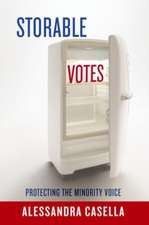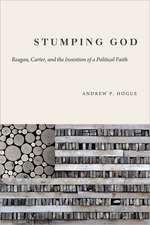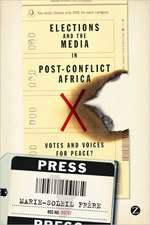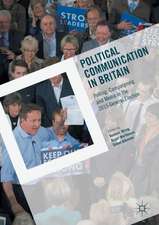Voting Procedures under Uncertainty
Autor Hannu Nurmien Limba Engleză Hardback – 27 mai 2002
| Toate formatele și edițiile | Preț | Express |
|---|---|---|
| Paperback (1) | 634.18 lei 43-57 zile | |
| Springer Berlin, Heidelberg – 21 iul 2012 | 634.18 lei 43-57 zile | |
| Hardback (1) | 638.89 lei 43-57 zile | |
| Springer Berlin, Heidelberg – 27 mai 2002 | 638.89 lei 43-57 zile |
Preț: 638.89 lei
Preț vechi: 751.64 lei
-15% Nou
Puncte Express: 958
Preț estimativ în valută:
122.25€ • 127.98$ • 101.15£
122.25€ • 127.98$ • 101.15£
Carte tipărită la comandă
Livrare economică 07-21 aprilie
Preluare comenzi: 021 569.72.76
Specificații
ISBN-13: 9783540433521
ISBN-10: 354043352X
Pagini: 172
Ilustrații: X, 156 p. 1 illus.
Dimensiuni: 155 x 235 x 15 mm
Greutate: 0.38 kg
Ediția:2002
Editura: Springer Berlin, Heidelberg
Colecția Springer
Locul publicării:Berlin, Heidelberg, Germany
ISBN-10: 354043352X
Pagini: 172
Ilustrații: X, 156 p. 1 illus.
Dimensiuni: 155 x 235 x 15 mm
Greutate: 0.38 kg
Ediția:2002
Editura: Springer Berlin, Heidelberg
Colecția Springer
Locul publicării:Berlin, Heidelberg, Germany
Public țintă
ResearchCuprins
1. Choice Theory and Constitutional Design.- 1.1 Theories and Models.- 1.2 Applying Social Choice Theory.- 1.3 Varying Assumptions.- 2. Chaotic Behavior of Models.- 2.1 The U.S. Presidential Elections.- 2.2 Referendum Paradox and the Properties of Majority Rule.- 2.3 How Chaotic Can It Get?.- 3. Results Based on Standard Model.- 3.1 Voting Procedures.- 3.2 Performance Criteria.- 3.3 Chaos, Strategy and Self Correction.- 4. Aggregating Voting Probabilities and Judgments.- 4.1 Avoiding Arrow’s Theorem via Average Rule.- 4.2 Condorcet’s Jury Theorem.- 4.3 Relaxing the Independence Assumption.- 4.4 Optimal Jury Decision Making.- 4.5 Thought Experiment: Council of Ministers as a Jury.- 5. Condorcet’s Rule and Preference Proximity.- 5.1 Condorcet’s Rule.- 5.2 Measuring Preference Similarity.- 5.3 Preference Proximity and Other Desiderata.- 5.4 Ranking and Choice Rules.- 5.5 Kemeny, Dodgson and Slater.- 6. Responses to Changes in Voter Opinions.- 6.1 Monotonicity, Maskin-Monotonicity and No-Show Paradox 92.- 6.2 The Strong No-Show Paradox.- 6.3 Qualified Majorities and No-Show Paradox.- 6.4 Monotonicity Violations of Voting Systems.- 6.5 Preference Truncation Paradox.- 6.6 Preference Misrepresentation.- 7. Mos Docendi Geometricus.- 7.1 The British Parliamentary Elections of 2001.- 7.2 Critique of Condorcet’s Intuition.- 7.3 Profile Decomposition.- 7.4 Berlin vs. Bonn Vote Revisited.- 8. Conclusions.- List of Figures 139 List of Tables.- Author Index.
Recenzii
From the reviews:
"The main objective of Voting Procedures under Uncertainty is to clarify how uncertainty pertains to the performance of voting procedures. This significant task is successfully undertaken … . this book is a useful, refreshing and challenging reading for students and researchers of collective decision making." (S. Nitzan, Journal of Economics, Vol. 80 (3), 2003)
"For the person interested in a ‘reader friendly’ introduction to the mathematics of voting theory, an outline of some of the more recent contributions to this area, or a reference book with references to the main results, I highly recommend Nurmi’s book." (Donald G. Saari, Mathematical Reviews, 2004 d)
"The author considers the impact of various types of uncertainty on social choice theory, and especially voting theory. … The explanations are clear and accompanied by either simple theoretical examples or ones drawn from recent political experience. The book contains a wealth of information for the interested reader." (Duncan J. Melville, Zentralblatt MATH, Vol. 1018, 2003)
"The main objective of Voting Procedures under Uncertainty is to clarify how uncertainty pertains to the performance of voting procedures. This significant task is successfully undertaken … . this book is a useful, refreshing and challenging reading for students and researchers of collective decision making." (S. Nitzan, Journal of Economics, Vol. 80 (3), 2003)
"For the person interested in a ‘reader friendly’ introduction to the mathematics of voting theory, an outline of some of the more recent contributions to this area, or a reference book with references to the main results, I highly recommend Nurmi’s book." (Donald G. Saari, Mathematical Reviews, 2004 d)
"The author considers the impact of various types of uncertainty on social choice theory, and especially voting theory. … The explanations are clear and accompanied by either simple theoretical examples or ones drawn from recent political experience. The book contains a wealth of information for the interested reader." (Duncan J. Melville, Zentralblatt MATH, Vol. 1018, 2003)
Caracteristici
Includes supplementary material: sn.pub/extras
















